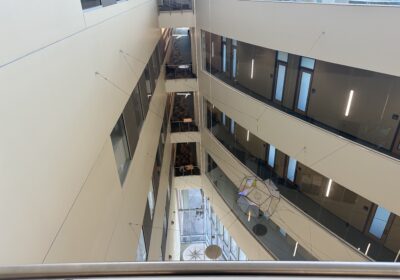Architect presents sustainability in artistic designs
“Master architect” Eddie Jones’ glass and stone home designs received a standing ovation from a crowd of about 100 students Tuesday night.
Jones, an Arizona based architect known for his innovative and sustainable home designs, shared his passion for the field in the School of Architecture and Community Design.
He walked students through the thought-process of how he used rammed-dirt to insulate buildings and how he used wooden beams to leave shadows, imitating the feel of being in a barn.
“The interior surface temperature of my walls never changes because they’re two feet thick,” Jones said. “It takes heat one hour to conduct one inch in rammed-dirt. With a 24-inch thick wall, 24 hours in a day, 12 hours of sunshine as the heat moves in, then the sun goes down.”
Jones explained how he and his brother were inspired by a fort they came across in the woods to build a nature center for children in Arlington, Texas.
He described it as an odd building, because it resembled a large fort.
Inside, a wooden beam draws the eye to a ceiling that resembles a leaf.
“[I want it] to encourage small children to begin to respect and appreciate the landscape, and there’s no such thing as ownership,” Jones said. “You can only require responsibility to take care of the land.”
Jones said sustainability plays a big part in his architecture.
At the University of Arizona, he was asked to design an addition to the original School of Architecture. The design he built included an 11,000-gallon fiberglass storage tank that harvested rainwater. The tank irrigated the landscape, which grew vines that grew up the south side of the building, mitigating heat gain and filtering sunlight.
“Now architecture students are saying ‘Wow, landscaping is really important because it’s allowing my building to exist in a responsible way.’ It’s showing how architecture and landscape are interdependent,” he said.
Students in the audience, such as Edes Ikhouria, a non-degree seeking student taking architecture classes, were able to relate to Jones’ discussion about his work as an architect, and learned that each person they hear from has a different idea for how designs should look.
“When you’re talked to by different lecturers and professors you find they all have different schools of thought,” Ikhouria said. “You feel like some of your ideas are limited because you have to please a professor. You don’t come out as your own person as an architect. When you get out of school, sometimes you start practicing and find yourself.”
At the end of the lecture, Jones told students he’s just as insecure about his designs as they can be, but encouraged students not to give up on their work.
“You have to do it for the love of architecture, and then the money will come,” he said.
Jones told the students that being an architect is easier than being a student. First-year graduate student Savannah Mason said she agreed the student life was hard.
“One main difficulty is time management and lack of sleep,” she said. “We have our own fridge, microwave and coffeepot in our studio, and there’s even a cot under our desk.”
“I started out how you guys did, how your professors did,” Jones said. “You can’t give up, you can’t sell out.”
While on campus, Jones said he got a chance to view students’ work and was impressed.
“I know you’re working very hard,” Jones said. “I can see it in the studio and all the students I saw today are doing way better than when I was in school. There’s so many reasons for you to give up, but if you can just hang in there, you will have a great career and great life.”






